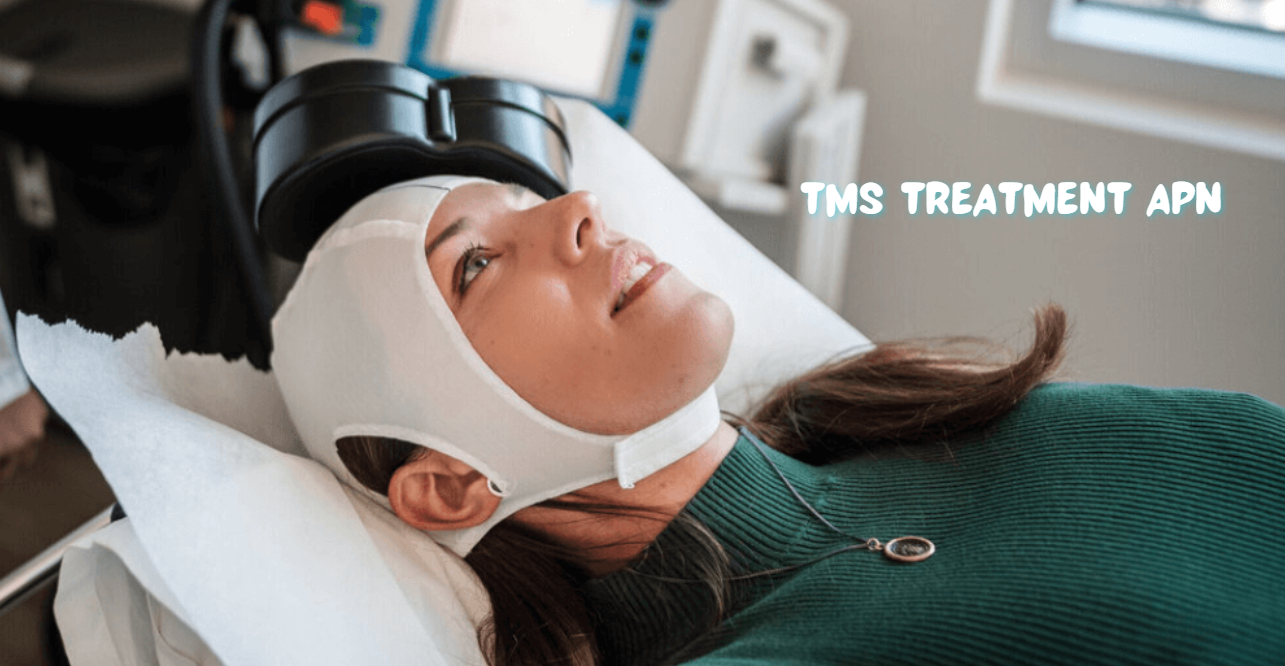Understanding TMS Treatment APN: A Comprehensive Guide
Introduction to TMS Treatment
Transcranial Magnetic Stimulation (TMS) is a groundbreaking noninvasive therapy that has revolutionized the treatment of various mental health conditions, particularly depression.
As mental health issues continue to rise in the United States, there is a growing need for effective treatments that go beyond traditional medication and psychotherapy. TMS treatment APN is one such solution, offering hope to those who have not found relief through conventional methods.
In this comprehensive article, we will delve into the intricacies of TMS treatment APN, exploring its mechanisms, effectiveness, and applications. We’ll also discuss its benefits, potential side effects, and how it compares to other treatments. This guide is designed to provide a thorough understanding of TMS treatment, helping individuals make informed decisions about their mental health care.
What is TMS Treatment?
The Basics of Transcranial Magnetic Stimulation
Transcranial Magnetic Stimulation (TMS) is a noninvasive procedure that uses magnetic fields to stimulate nerve cells in the brain. It was first developed in the 1980s, but it wasn’t until 2008 that the U.S. Food and Drug Administration (FDA) approved it as a treatment for major depressive disorder (MDD) in patients who had not responded to other therapies.
TMS treatment APN works by delivering repetitive magnetic pulses to specific areas of the brain, particularly those involved in mood regulation. These pulses create small electrical currents that stimulate nerve cells, potentially improving communication between different regions of the brain. Over time, this can lead to a reduction in symptoms of depression and other mental health conditions.
Different Types of TMS
There are several types of TMS treatments, each with its own approach and technology:
- Repetitive TMS (rTMS): This is the most common form of TMS, involving repeated pulses of magnetic energy to targeted areas of the brain. It’s typically used for treating depression.
- Deep TMS (dTMS): Deep Transcranial Magnetic Stimulation is a more advanced form of TMS that penetrates deeper into the brain, allowing for the stimulation of larger and more diverse brain regions. It’s particularly effective for patients with treatment-resistant depression, anxiety, OCD, and smoking addiction.
- Theta Burst Stimulation (TBS): This is a newer, faster form of TMS that uses shorter bursts of magnetic pulses. It’s designed to be as effective as traditional TMS but with shorter treatment times.
How TMS Treatment APN Works
Mechanism of Action
The mechanism behind TMS treatment APN is relatively straightforward yet highly effective. The treatment involves placing an electromagnetic coil against the patient’s scalp, usually near the forehead. This coil generates a magnetic field that passes through the skull and induces electrical currents in the brain. These currents stimulate the neurons in the targeted brain regions, enhancing their activity.
For depression, TMS typically targets the prefrontal cortex, an area of the brain responsible for mood regulation. By stimulating this region, TMS can help restore normal brain function, leading to improved mood and reduced symptoms of depression.
The Treatment Process
A typical TMS treatment session lasts about 30 to 40 minutes. During the session, the patient remains awake and alert, sitting comfortably in a chair. The electromagnetic coil is positioned on the patient’s head, and the treatment begins. Patients may feel a tapping sensation on their scalp and hear a clicking sound from the machine, but the procedure is generally well-tolerated.
TMS treatment is usually administered five days a week for four to six weeks, depending on the patient’s condition and response to therapy. Unlike medications, which may take weeks or even months to show effects, many patients begin to notice improvements in their symptoms within the first few weeks of TMS therapy.
Applications of TMS Treatment APN
Treating Major Depressive Disorder (MDD)
The most common application of TMS treatment APN is in the treatment of Major Depressive Disorder, especially in patients who have not responded well to antidepressant medications. Clinical studies have shown that TMS can significantly reduce depressive symptoms and, in some cases, lead to full remission.
For patients who have tried multiple medications without success, TMS offers a promising alternative that is both effective and free from the systemic side effects associated with drugs.
Addressing Anxiety Disorders
Anxiety disorders, including generalized anxiety disorder (GAD) and panic disorder, are also potential candidates for TMS treatment. While the FDA has not officially approved TMS for anxiety, preliminary research and clinical practice suggest that it can be effective in reducing anxiety symptoms, particularly when used in conjunction with other treatments.
Treatment of Obsessive-Compulsive Disorder (OCD)
In 2018, the FDA approved deep TMS (dTMS) for the treatment of Obsessive-Compulsive Disorder (OCD). OCD is a chronic condition characterized by intrusive thoughts and repetitive behaviors, and it can be particularly challenging to treat. TMS treatment APN offers a noninvasive option for patients who have not responded to traditional therapies, providing relief from the distressing symptoms of OCD.
Smoking Addiction and Other Applications
Beyond mental health, TMS treatment APN is also being explored as a treatment for smoking addiction. By targeting brain regions associated with cravings and addiction, TMS can help reduce the desire to smoke and increase the chances of quitting successfully. Other potential applications of TMS include treatment for post-traumatic stress disorder (PTSD), chronic pain, and even neurological conditions like Parkinson’s disease.
Benefits of TMS Treatment APN
Noninvasive and Drug-Free
One of the most significant advantages of TMS treatment APN is that it is noninvasive, meaning there is no need for surgery or implantation of devices. This makes it a safer option compared to other treatments like electroconvulsive therapy (ECT). Additionally, TMS is drug-free, which means it does not carry the same risk of side effects commonly associated with antidepressants and other psychiatric medications.
Minimal Side Effects
TMS treatment is generally well-tolerated, with few side effects. The most common side effects are mild scalp discomfort and headaches, which typically resolve shortly after treatment. Unlike medications, TMS does not cause systemic side effects like weight gain, sexual dysfunction, or gastrointestinal issues.
Effective for Treatment-Resistant Conditions
For patients with treatment-resistant depression or other conditions that have not responded to traditional therapies, TMS treatment APN offers a new avenue of hope. Studies have shown that TMS can be effective in cases where other treatments have failed, providing relief to patients who may have otherwise felt hopeless.
Quick Recovery and Convenience
TMS treatment does not require anesthesia or a recovery period, meaning patients can return to their daily activities immediately after each session. This convenience makes TMS an attractive option for those with busy schedules who cannot afford to take time off for more intensive treatments.
Potential Side Effects and Risks
Common Side Effects
While TMS treatment APN is generally safe, there are some potential side effects that patients should be aware of:
- Scalp Discomfort: Mild discomfort at the treatment site is common, especially during the first few sessions.
- Headaches: Some patients experience headaches following treatment, but these are usually mild and can be managed with over-the-counter pain relievers.
- Tingling Sensations: Some patients report tingling or twitching of facial muscles during treatment, which is generally harmless and temporary.
Rare but Serious Risks
Though rare, there are some more serious risks associated with TMS treatment:
- Seizures: In very rare cases, TMS can induce seizures, particularly in patients with a history of epilepsy. However, the risk is extremely low, and precautions are taken to minimize this risk.
- Hearing Loss: Prolonged exposure to the clicking sound during TMS treatment could potentially lead to hearing loss, though this risk is mitigated by the use of earplugs during the procedure.
TMS Treatment APN vs. Other Treatments
TMS vs. Medications
When comparing TMS treatment APN to medications, one of the most significant differences is the absence of systemic side effects. While antidepressants and other psychiatric medications affect the entire body, TMS targets only specific areas of the brain, reducing the likelihood of side effects like weight gain, sexual dysfunction, and fatigue. Moreover, TMS does not carry the risk of drug interactions, making it a safer option for patients taking multiple medications.
TMS vs. Electroconvulsive Therapy (ECT)
Electroconvulsive Therapy (ECT) is another treatment option for severe depression, particularly in cases where patients are unresponsive to medications. However, ECT is a more invasive procedure that requires anesthesia and can cause memory loss and other cognitive side effects. TMS treatment APN, on the other hand, is noninvasive and does not require anesthesia, making it a safer and more convenient alternative.
TMS vs. Psychotherapy
While psychotherapy remains a cornerstone of mental health treatment, it may not be sufficient for all patients, particularly those with severe or treatment-resistant conditions. TMS treatment APN can be used in conjunction with psychotherapy to enhance its effectiveness, providing a more comprehensive approach to treatment.
Who is a Good Candidate for TMS Treatment APN?
Ideal Candidates
TMS treatment APN is suitable for individuals who:
- Have been diagnosed with Major Depressive Disorder or other mental health conditions and have not responded to medications or psychotherapy.
- Are unable or unwilling to take psychiatric medications due to side effects or other concerns.
- Are seeking a noninvasive, drug-free treatment option with minimal side effects.
- Are looking for a treatment that allows them to maintain their daily activities without significant disruption.
Who Should Avoid TMS?
TMS treatment may not be appropriate for individuals with certain medical conditions or implants, such as:
- A history of seizures or epilepsy.
- Metal implants in the head or neck, including cochlear implants, aneurysm clips, or deep brain stimulators.
- Severe cardiovascular conditions that may be affected by the magnetic pulses.
It’s essential for patients to discuss their medical history with their healthcare provider before starting TMS treatment to ensure it is safe and appropriate for them.
How to Access TMS Treatment APN
Finding a TMS Provider
TMS treatment APN is offered at specialized mental health clinics and some hospitals across the United States. To find a provider, patients can consult their primary care physician or mental health specialist, who can provide a referral to a TMS treatment center. It’s important to choose a provider with experience and expertise in administering TMS to ensure the best possible outcomes.
Insurance Coverage and Cost
One of the concerns patients may have about TMS treatment is the cost. While TMS is generally more expensive than medication, many insurance plans now cover TMS for the treatment of Major Depressive Disorder. Patients should check with their insurance provider to determine coverage and out-of-pocket costs. For those without insurance coverage, some clinics offer payment plans or sliding scale fees to make treatment more accessible.
Frequently Asked Questions (FAQs)
1. How long does it take to see results from TMS treatment?
Many patients begin to notice improvements in their symptoms within the first two to three weeks of TMS treatment APN. However, the full benefits of treatment may not be apparent until the completion of the treatment course, which typically lasts four to six weeks.
2. Is TMS treatment painful?
TMS treatment is generally well-tolerated and is not considered painful. Some patients may experience mild scalp discomfort or headaches during the first few sessions, but these side effects usually subside over time.
3. Can TMS be used in conjunction with other treatments?
Yes, TMS treatment APN can be used alongside other treatments, such as medications and psychotherapy, to enhance their effectiveness. It’s important to discuss all current treatments with a healthcare provider to ensure a coordinated approach to care.
4. How effective is TMS treatment for depression?
Clinical studies have shown that TMS is effective in reducing symptoms of depression in patients who have not responded to other treatments. Success rates vary, but many patients experience significant improvements, with some achieving full remission.
5. What happens if TMS treatment doesn’t work?
If TMS treatment APN does not produce the desired results, patients may explore other treatment options, such as medication adjustments, psychotherapy, or alternative therapies. It’s important to work closely with a healthcare provider to determine the best course of action.
Conclusion
TMS treatment APN represents a promising advancement in the field of mental health care, offering hope to individuals with treatment-resistant conditions. With its noninvasive nature, minimal side effects, and effectiveness in treating a range of mental health disorders, TMS is becoming an increasingly popular choice for patients seeking alternatives to traditional treatments.
For those considering TMS treatment APN, it’s essential to consult with a qualified healthcare provider to determine if this therapy is right for them. With the right approach, TMS can be a powerful tool in the journey toward mental health and well-being.






